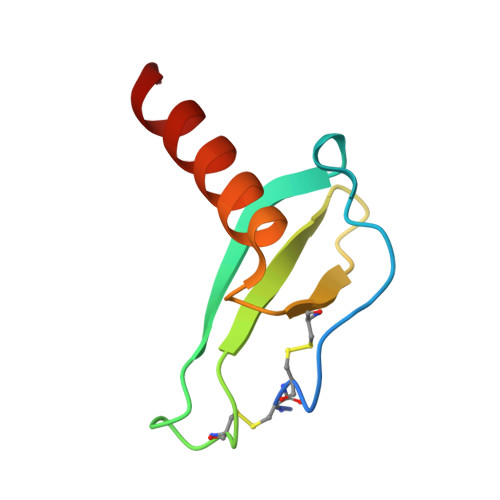Protein engineering of the chemokine CCL20 prevents psoriasiform dermatitis in an IL-23-dependent murine model.
Getschman, A.E., Imai, Y., Larsen, O., Peterson, F.C., Wu, X., Rosenkilde, M.M., Hwang, S.T., Volkman, B.F.(2017) Proc Natl Acad Sci U S A 114: 12460-12465
- PubMed: 29109267
- DOI: https://doi.org/10.1073/pnas.1704958114
- Primary Citation of Related Structures:
5UR7 - PubMed Abstract:
Psoriasis is a chronic inflammatory skin disease characterized by the infiltration of T cell and other immune cells to the skin in response to injury or autoantigens. Conventional, as well as unconventional, γδ T cells are recruited to the dermis and epidermis by CCL20 and other chemokines. Together with its receptor CCR6, CCL20 plays a critical role in the development of psoriasiform dermatitis in mouse models. We screened a panel of CCL20 variants designed to form dimers stabilized by intermolecular disulfide bonds. A single-atom substitution yielded a CCL20 variant (CCL20 S64C) that acted as a partial agonist for the chemokine receptor CCR6. CCL20 S64C bound CCR6 and induced intracellular calcium release, consistent with G-protein activation, but exhibited minimal chemotactic activity. Instead, CCL20 S64C inhibited CCR6-mediated T cell migration with nominal impact on other chemokine receptor signaling. When given in an IL-23-dependent mouse model for psoriasis, CCL20 S64C prevented psoriatic inflammation and the up-regulation of IL-17A and IL-22. Our results validate CCR6 as a tractable therapeutic target for psoriasis and demonstrate the value of CCL20 S64C as a lead compound.
Organizational Affiliation:
Department of Biochemistry, Medical College of Wisconsin, Milwaukee, WI 53226.
















